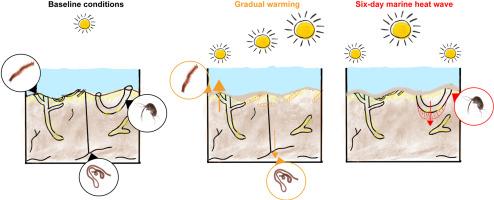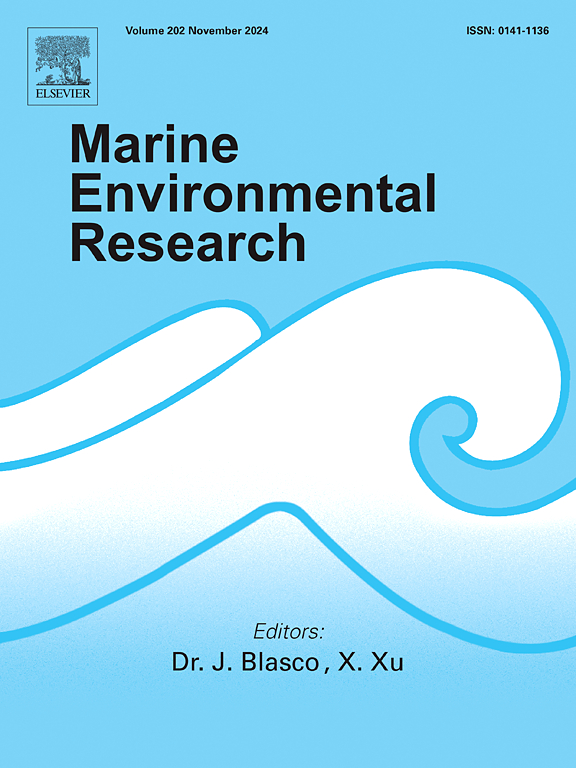新技术实验揭示了与海洋热浪相比,海洋生物湍流对逐渐变暖的反应之间的关键差异
IF 3.2
3区 环境科学与生态学
Q2 ENVIRONMENTAL SCIENCES
引用次数: 0
摘要
海水温度波动通过破坏底栖物种的生物扰动(挖洞和沉积物混合)活动来影响浅海生态系统,而底栖物种的生物扰动活动反过来又会强烈影响海底地球化学循环,包括沉积物氧合作用、有机物降解和营养物再生。虽然气候变化预计会在一系列环境中增加水温,特别是在中纬度到高纬度的沿海环境中,但人们对这些变化的时间动态(例如,变暖的速度、持续时间和频率)如何影响生物扰动器行为的理解有限。在这项研究中,我们使用来自康涅狄格州海岸的常见底栖生物扰动(多毛类和片脚类)来研究模拟海洋热浪(MHWs)和逐渐变暖的条件如何影响中环境实验中的生物扰动和洞穴特征。此外,我们利用对洞穴形态变化的实验观察,为从微量化石组合中诊断变暖的影响制定了新的标准,从而为了解过去变暖事件对海底群落的影响提供了一个新的窗口。我们的研究结果表明,与逐渐变暖相比,模拟海洋热浪的条件(即间歇性变暖)对生物扰流器有明显的对比影响。我们观察到,对于多毛线虫来说,逐渐变暖增加了洞穴面积,减小了最大洞穴深度,而高温条件的影响有限。对鱼科多毛类来说,逐渐变暖增加了最大洞穴深度,而高温降低了洞穴面积。对片脚类动物来说,在高强度条件下,洞穴面积和最大深度都增加了。这些结果表明,温度变化对生物扰流器的影响是物种和生态特异性的;同一群落内不同的动物类群对热的耐受性存在显著差异。本文章由计算机程序翻译,如有差异,请以英文原文为准。

Neoichnological experiments reveal key differences between marine bioturbator responses to gradual warming compared to marine heat waves
Seawater temperature fluctuations influence shallow marine ecosystems by disrupting the bioturbating (burrowing and sediment-mixing) activities of benthic species, which can, in turn, strongly affect seafloor geochemical cycling, including sediment oxygenation, organic matter degradation and nutrient regeneration. Although climate change is expected to increase water temperatures across a range of settings, particularly in mid-to high-latitude coastal environments, there is limited understanding of how the temporal dynamics of these changes (e.g., rate, duration and frequency of warming) will shape bioturbator behaviors. In this study, we used common benthic bioturbators (polychaetes and amphipods) from the Connecticut coast to investigate how conditions simulating both marine heat waves (MHWs) and gradual warming influence bioturbation and burrow features in mesocosm experiments. In addition, we use experimental observations of changes in burrow morphology to develop new criteria for diagnosing the impact of warming from trace fossil assemblages, thus providing a new window into the impact of past episodes of warming on seafloor communities. Our findings indicate that conditions simulating marine heat waves (i.e., episodic, punctuated warming) have distinct and contrasting effects on bioturbators relative to gradual warming. We observe that, for nereid polychaetes, gradual warming increased burrow area and decreased maximum burrow depth, whereas MHW conditions had limited effect. For eunicid polychaetes, gradual warming increased maximum burrow depth, whereas MHWs decreased burrow area. For amphipods, both burrow area and maximum burrow depth increased under MHW conditions. These results highlight that the effects of temperature variations on bioturbators are species- and ecology-specific; different infaunal taxa living within the same community have notably different thermal tolerances.
求助全文
通过发布文献求助,成功后即可免费获取论文全文。
去求助
来源期刊

Marine environmental research
环境科学-毒理学
CiteScore
5.90
自引率
3.00%
发文量
217
审稿时长
46 days
期刊介绍:
Marine Environmental Research publishes original research papers on chemical, physical, and biological interactions in the oceans and coastal waters. The journal serves as a forum for new information on biology, chemistry, and toxicology and syntheses that advance understanding of marine environmental processes.
Submission of multidisciplinary studies is encouraged. Studies that utilize experimental approaches to clarify the roles of anthropogenic and natural causes of changes in marine ecosystems are especially welcome, as are those studies that represent new developments of a theoretical or conceptual aspect of marine science. All papers published in this journal are reviewed by qualified peers prior to acceptance and publication. Examples of topics considered to be appropriate for the journal include, but are not limited to, the following:
– The extent, persistence, and consequences of change and the recovery from such change in natural marine systems
– The biochemical, physiological, and ecological consequences of contaminants to marine organisms and ecosystems
– The biogeochemistry of naturally occurring and anthropogenic substances
– Models that describe and predict the above processes
– Monitoring studies, to the extent that their results provide new information on functional processes
– Methodological papers describing improved quantitative techniques for the marine sciences.
 求助内容:
求助内容: 应助结果提醒方式:
应助结果提醒方式:


